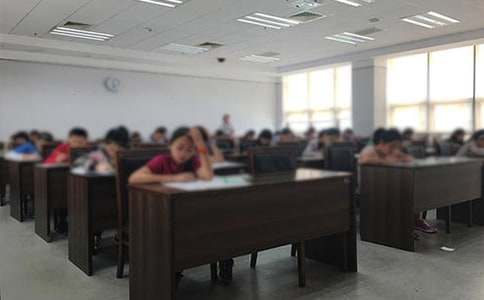- 相关推荐
2017年职称英语等级考试试题理工类模拟卷
Inventor of LED

When Nick Holonyak set out to create a new kind of visible lighting using semiconductor alloys, his colleagues thought he was unrealistic. Today, his discovery of light-emitting diodes or1 LEDs, are used in everything from DVDs to alarm clocks to airports. Dozens of his students have continued his work, developing lighting used in traffic lights and other everyday technology.
On April 23, 2004, Holonyak received the $500,000 Lemelson-MIT Prize at a ceremony in Washington. This marks the 10th year that the Lemelson-MIT Program at the Massachusetts Institute of Technology(MIT)has given the award to prominent inventors.
"Anytime you get an award, big or little2, it's always a surprise," Holonyak said.
Holonyak, 75, was a student of John Bardeen, an inventor of the transistor, in the early 1950s. After graduate school3, Holonyak worked at Bell Labs. He later went to General Electric4, where he invented a switch now widely used in house dimmer switches5.
Later, Holonyak started looking into how semiconductors could be used to generate light. But while his colleagues were looking at how to generate invisible light, be wanted to generate visible light. The LEDs he invented in 1962 now last about 10 times longer than incandescent bulbs, and are more environmentally friendly and cost effective.
Holonyak, now a professor of electrical and computer engineering and physics at the University of Illinois, said he suspected that LEDs would become as commonplace as they are today. But didn't realize how many uses they would have.
"You don't know in the beginning. You think you're doing something important, you think it's worth doing, but you really can't tell what the big payoff is going to be, and when, and how. You just don't know," he said.
The Lemelson-MIT Program also recognized Edith Flanigen, 75, with the $100,000 Lemelson- MIT Lifetime Achievement Award for her work on a new generation of "molecular sieves" that can separate molecules by size.
词汇:
semiconductor / ?sem?k?n’d?kt?(r) /n.半导体
alloy / ’?l??, ?’l??/ n.合金
emit / ?’m?t / v.发射,发出
diode / ’da???d/n.二极管
dim / d?m / adj.灯光昏暗的
incandescent / ,?nk?n’desnt / adj.白炽的
bulb / b?lb /n.灯泡
commonplace / ’k?m?nple?s / adj.普通的
molecular / m?(?)’lekj?l?(r) / adj.分子的
sieve / s?v / n.筛
注释:
1.or:即
2.big or little:不论是大还是小
3.after graduate school:从研究生院毕业之后
4.General Electric :通用电气公司
5.house dimmer switches:家用减光开关
练习:
1.Holonyak's colleagues thought he would fail in his research on LEDs at the time when he started it.
A Right B Wrong C Not mentioned
2.Holonyak believed that his students that were working with him on the project would get the Lemelson-MIT Prize sooner or later.
A Right B Wrong C Not mentioned
3.Holonyak was the inventor of the transistor in the early 1950s.
A Right B Wrong C Not mentioned
4.Holonyak believed that LEDs would become very popular in the future.
A Right B Wrong C Not mentioned
5.Holonyak said that you should not do anything you are not interested in.
A Right B Wrong C Not mentioned
6.Edith Flanigen is the only co-inventor of LEDs.
A Right B Wrong C Not mentioned
7.The Lemelson-MIT Prize has a history of over 100 years.
A Right B Wrong C Not mentioned
答案与题解:
1.A 第一段第一句就说:“When Nick Holonyak set out to create a new kind of visible lighting using semiconductor alloys, his colleagues thought he was unrealistic.”
2.C通篇文章没有提到Holonyak相信他的学生将获得Lemelson-MIT Prize这件事。
3.B第四段说到发明晶体管的是Holonyak的老师John Bardeen,不是Holonyak本人。
4.A 第六段的句子“... he suspected that LEDs would become as commonplace as they are today ...”就包含了popular的意思。
5.C通篇文章(包括第七段)没有提到“不要做你不感兴趣的事”。
6.C通篇文章没有提到Edith Flanigen是Holonyak发明LEDs的合作者,更不要说是唯一的合作者。
7.B 第二段说到,2004年是the Lemelson-MIT Prize成立10周年,按此推算,the Lemelson- MIT Prize是在1994年设立的。
译文:LED的发明者
当Nick Holonyak着手用半导体含金创造一种新的可视照明设备的时候,同事们都认为他不现实。今天,他发现的发光二极管,或叫 LED,使用范围覆盖从 DVD到机场警钟的一切东西。他的许多学生继续着他的工作,发明了交通灯中使用的照明设备和其他的日用技术。
2004年 4月 23号,Holoyak在华盛顿的一次典礼上被授予 Lemelson-MIT项目的 50万美元的奖金。这是麻省理工的 Lemelson-MIT项目第十年颁奖给杰出的发明人。
“任何时候你得了奖,不论是大是小,总是一分惊喜。” Holonyad说。
Holonyak,75岁,是 20世纪 50年代初期晶体管的发明者 John Bardeen的学生。从研究生院毕业之后, Holonyak在 Bell实验室工作。之后去了通用电器公司,在那里他发明了一种开关,现在家用减光开关中普遍使用。
后来, Holonyak开始研究如何应用半导体发电。当他的同事们正在研究如何发出看不见的光时,他却想要看得见的光。 1962年他发明的 LED,现在的使用寿命可以比白炽灯泡长十倍,而且更环保、更经济。
Holonyak现在是伊利诺斯大学电子、计算机工程和物理专业的教授,他说他预料到 LED的使用有可能像今天这样普遍,但没有意识到它会有多少用途。
“开始的时候你并不知道,你认为你在做一件很重要的事情,你认为它值得做,但是你不能说出要付出多大的代价,什么时候付出,怎样付出。你并不知道。”他说。
Lemelson-MIT项目同样授予 75岁的 Edith Flanigen 10万美元的终身成就奖,她的成就是创造新一代的“分子筛”,也就是可以通过大小来分离分子。
【职称英语等级考试试题理工类模拟卷】相关文章:
全国职称英语等级考试试题(理工类)07-29
全国职称英语等级考试试题(理工类)07-29
